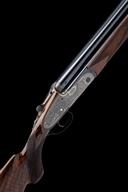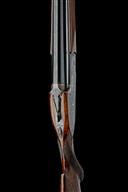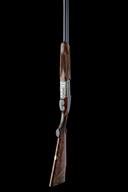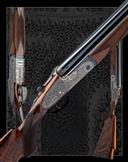Product Details
J. WOODWARD & SONS
A 12-BORE 1913 PATENT SINGLE-TRIGGER OVER AND UNDER SIDELOCK EJECTOR LIVE PIGEON GUN, serial no. 6871,
for 1929, 30in. nitro barrels with raised solid file cut top-rib with intermediate bead sight, the over barrel engraved 'JAMES WOODWARD & SONS. 64. ST. JAMES'S STREET. LONDON. ENGLAND.', 2 3/4in. chambers, bored approx. 1/2 and full choke, C.L Woodward, W.P. Evershed and C. Hill patent action, patent no. 4986 of 27th February 1913 with side bolsters, hold-open toplever, manual t-bar safety with gold-inlaid 'SAFE' detail, gold-inlaid cocking-indicators, later conversion to single trigger, best fine acanthus scroll engraving with floral bouquets, the makers name in elaborate cartouches to the lockplates, the underside with 'WOODWARD'S - PATENT - UNDER & OVER - ', retaining some colour-hardening and finish, 14 3/4in. highly-figured replacement pistolgrip stock with raised comb, fore-end wood likely replacement, weight 8lb., in a brass-cornered oak and leather case
Provenance: The makers have kindly provided us with the following information:
Completed: 31st January 1929
For: George Moore
Description: An over & under pigeon gun
Weight: 7lb. 14oz.
Calibre: 12-bore (2 3/4in. Case)
Barrels: 30in. Nickel Steel
Choke: 3/4 & Ex. Full
Stock: 14 1/8in. (cast-on)
Notes:
File cut flat top rib
Semi-pistolgrip stock with rubber recoil-pad and silver oval
Double triggers
George Gordon Moore, born in Ontario, Canada in 1875, was a man of diverse talents and interests. By the age of 21, he had already become a partner in a law firm in Michigan, demonstrating a keen business acumen that led to his first fortune in the early 1900s. He was also known as a socialite and sportsman, as well as an agent for the Whiting Manufacturing Company.
The company leased Moore 1,600 acres atop Hooper Bald in the Appalachian mountains, where he wanted to establish a European-style shooting preserve. Moore had hunted boar on a private estate in Belgium and wanted to replicate the experience for the American elite. Given the remoteness of the site, it was an ambitious undertaking, but Moore had the passion and money to make it happen.
In 1908 the remote site was only accessible by foot or horse, but by the time it was completed it had become a fully equipped preserve complete with a clubhouse boasting modern amenities such as indoor plumbing, electricity and telephone connectivity (albeit requiring extensive wiring through the mountains). The preserve boasted bison and Russian boar, Moore purchased 34 bears from zoos, 200 wild turkeys, more bison, mule deer and elk. To contain the animals, 25 tons of barbed wire was required.
The imported animals were not always easy to manage. The bears had no difficulty climbing out of their wire enclosure. As former zoo animals, they were all too comfortable with humans and frequently appeared at the hunting lodge, demanding to be fed. One night, Moore arrived at Hooper Bald to find one of his guests, a young Englishman, with his arm and leg bandaged from wounds that he'd suffered while trying to oust a bear from his room. Moore claimed to have found the bears antics "amusing."
Despite Moore's initial enthusiasm, the Hooper Bald project eventually faltered due to its remote location, leading to Moore's disillusionment with the venture. By the mid-1920s, the preserve was mostly abandoned, with only the caretaker, Cotton McGuire, remaining on site.
Moore's entrepreneurial spirit persisted, leading him to New York where he flourished as a lawyer-turned-businessman, advising President Woodrow Wilson on military matters. He built a fortune with investments while maintaining the life of a high-living bachelor; playing polo and hosting lavish parties. A party he threw at the famed Ritz in New York City in 1912 was described by a reporter as a bash that "in magnificence and sumptuousness has never been surpassed in the history of brilliant entertainments held in that smart hotel." He rekindled his desire to create a hunting preserve, this time at a ranch in California. It is during this time Moore made the acquaintance of author F. Scott Fitzgerald. In April of 1925 Fitzgerald's novel The Great Gatsby was published.
The story is set on Long Island's North Shore and in New York City during the summer of 1922, and there was much speculation that George Gordon Moore was the inspiration for Fitzgerald's Gatsby character. Throughout the twenties Moore spared no expense for lavish entertainment including extravagant parties that would include Hollywood starlets and in spite of prohibition, alcohol. The roaring twenties were alive and well at Rancho San Carlos.
In 1929, however, the stock market crash wiped away Moore's fortune. By 1939, hard-pressed to satisfy his creditors, Moore was forced to sell the California ranch. Little is known about his life afterward. In May 1971 George Gordon Moore died in Los Angeles, California at age 94.
Literature: 'James Woodward & Sons - Its History and Enduring Legacy' by Dr Nicholas Harlow, p. 89.
Please click HERE to view Terms & Conditions. Please note all Lots are listed in accordance with UK Law, for overseas buyers, please ensure you are familiar with your relevant local firearms and customs regulations before bidding.
Estimate £10,000-15,000
S2 - Sold as a Section 2 Firearm under the 1968 Firearms Act












